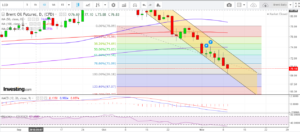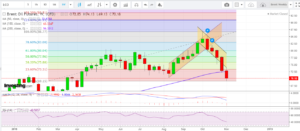Crude Oil
Oil prices continued to fall as traders stayed fixated on rising global crude supplies and moved prices into bear market territory.. Brent crude futures settled 47 cents lower at $70.18 a barrel, after piercing $ 70.00 /bbl during the day. WTI crude futures also lost 48 cents to settle at $60.19 a barrel, after breaking the $ 60.00 barrier.
For the week, Brent lost 3.6% while WTI lost 4.7%. Both contracts registered their 5th straight weekly loss. WTI has a falling streak now of 10 days, the longest streak since mid l984. Brent too has fallen 9 days out of the last 10.
U.S. crude output reached a new record high of 11.6 million bpd in the last week. To add more pressure to the market, the number of rigs pressed into active service has risen by 12.
Demand worries followed forecasts for slower economic growth in 2019, largely due to a U.S.-China trade war.
Hedge funds cut bullish wagers on U.S. crude in the latest week to the lowest level in more than a year, while speculators slashed bullish bets on Brent crude to the lowest since July 2017.
In the meanwhile, Saudi Arabia has declared it will cut exports in December by 500 kb/d in light of seasonally lower demand as well as fears of oversupply causing decline in prices.
Russia is reportedly demanding payment in Euros in their annual negotiation of term crude contracts as it seeks to protect itself from possible new US sanctions.
![]()


Oil prices have posted their fifth weekly loss in a row. The monthly chart has broken below the rising channel it was in for the last two months. The weekly chart also has broken below its channel. The difference is that the channel was falling! Brent has posted losses on 9 of the last 10 days of trading.
These falls would truly confirm the end of the long bullish trend that Brent had been coasting on for the last two years.
Trading Strategy
Last week we had suggested buying around $ 72.60 targeting first $ 73.50 and then $ 74.25-50. We had also cautioned that momentum trading could take prices to below our stop loss level of $ 71.75 towards our medium term target of $ 69.90. Traders who booked profit at the first target would have been happy.
With our medium term target of $ 69.90 having been touched for now, we would recommend sitting on the sidelines till some clear direction emerges. As of now, momentum could take it further lower to breach last week’s low of $ 69.17, even though oscillators and the streak would suggest some kind of hold back / support here.
Supports and Resistances
The first support lies in the $ 69.90 – $70.20 area. The next support is seen at $ 69.00-20 or the lows of last week. Below that support is seen around the $ 68.00 mark.
The first resistance is around the $ 70.50-60 area followed by the $ 71.10-20 area and then around $ 73.50-60/bbl.
For more and bigger charts please refer to our Technical Views page.
Naphtha
Not much news on Asian Naphtha market today.
Meanwhile, ARA naphtha stocks climbed to 261 KT on the week to Nov. 8, up by 20 KT from the week before. Some German chemical sites, such as Ludwigshaven and Dormagen, took in less than usual in the past week, contributing to a rise in Naphtha stocks, according to Dutch consultancy PJK International.
The November crack has dropped to – $ 8.90 / bbl. The December crack is at -$ 8.20 /bbl
Gasoline
Asia’s gasoline crack bounced back on Friday, recovering some of the steep losses this week which saw the crack flip into a discount on Thursday for the first time in years due to a persistent supply glut.
This came as European storage data showed a weekly drop in gasoline inventory figures. But some trade sources warned there could be further downside potential as refiners continue to produce more of the fuel due to strong middle and heavy distillate refining margins.
Gasoline stocks held at ARA fell 42 KT in the week to Nov. 8 to a six-week low of 943 KT. ARA gasoline stocks were 3 percent higher than a year ago.
The November crack has dropped nevertheless to $ 0.65 /bbl. The December crack is at 0.90 / bbl
Click Here for a graphical depiction of Global Gasoline stocks by region.
Distillates
Asia’s cash premiums for 10ppm gasoil fell on Friday to their lowest levels in more than two months at 27 cents a barrel to Singapore quotes on Friday, from a premium of 35 cents a barrel on Thursday amid rising supplies and lacklustre buying interest.
The availability of gasoil is increasing as some Asian refineries, undergoing planned seasonal maintenance, are now returning and ramping up output.
Meanwhile, low water levels on the Rhine have caused a fuel supply deficit in parts of Europe’s industrial heartlands that is sucking up cargoes from more than 10,000 km away in Singapore.
Northwest European prices for gasoil this week hit a record $35-per-tonne premium over Singapore values for November fuel deliveries.
Jet fuel cash differentials were at a discount of 32 cents a barrel to Singapore quotes on Friday, compared with a discount of 33 cents a barrel on Thursday.
ARA onshore middle distillates stocks dropped by 133 KT to 2.37 million tonnes. Levels are still 320 KT higher than the previous year.
The November crack has jumped once again is slightly higher at $ 16.85 /bbl with the 10 ppm crack at $ 17.70 /bbl. The regrade is steady at $ 0.70 /bbl.
The December crack is at $ 17.05 /bbl with the 10 ppm crack at $ 18.00 /bbl. The regrade is at $ 1.50 /bbl
Click Here for a graphical depiction of Global Distillate stocks by region.
Fuel Oil
Ex-wharf premiums held firm on Friday as limited supplies of finished grade 380-cst high-sulphur fuel oil for prompt deliveries continued to feed bullish sentiment. 380-cst fuel oil ex-wharf premiums ranged between around $20 and $30 per tonne and were higher than Singapore quotes on Friday, depending on delivery dates.
The earlier the delivery dates, the higher the premiums, the sources added, reflecting the lack of finished grade bunker fuels for prompt delivery in the Singapore trading and bunkering hub. Last week, ex-wharf premiums were trading at about $10-$12 per tonne to Singapore quotes. Ex-wharf premiums have typically traded in the low single-digit premiums for the most of 2018.
A lack of cutter stocks and the arrival of November arbitrage supplies only in the second half of the month have contributed to already tight Singapore fuel oil supplies, following limited arbitrage inflows in October.
ARA onshore fuel oil inventories rose by 317 KT to 1.26 million tonnes, a nine week high.
The November 180 cst crack has eased to +$ 3.55 / bbl with the visco spread at $ 0.65 /bbl
The December 180 cst crack has eased to +$ 2.05 / bbl with the visco spread at $ 0.80 /bbl
Click Here for a graphical depiction of Fuel Oil stocks by region.
Hedge Recommendations
Fuel Oil cracks seem to be easing off and our last hedges seem to have come into positive territory.
While gasoil cracks seem to be easing in the prompt, the Cal 19 strip is still strong. We particularly like the regrade but will wait for a few days before we put a hedge in place. $ 1.35 is the current value for the whole year. This is an excellent level to hedge.
Hedge recommendations are essentially made for refiners. These are not trading positions as such. The rationale of these positions is to lock in extraordinary levels for the refiner.
Click Here to see how all our recommendations have fared
About this blog
This blog post attempts to give a top level summary of the Singapore market goings on to a person who seeks to obtain a directional sense of the market on a daily basis.